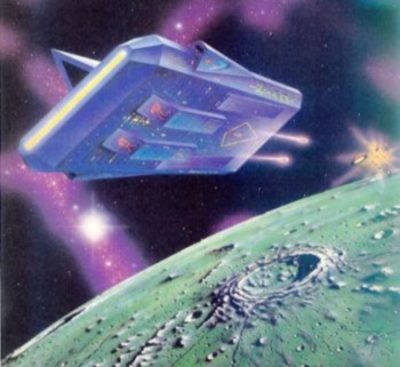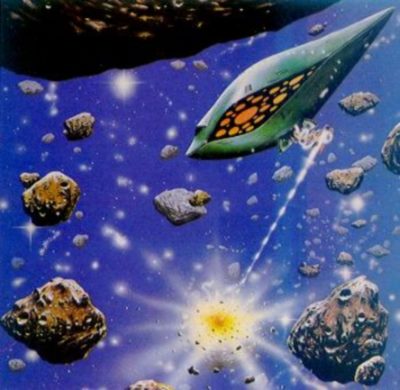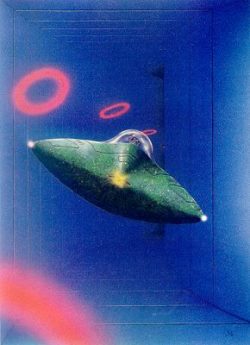
ZONE 49 for Procom — unpublished
Packaging has become an important and often enjoyable part of anything that gets sold on a shop’s shelf. Books and record album covers have developed into an art form of their own. Recently the same has happened with computer game cassette covers. Often the artists who do this work remain unknown to the general public in all but their style. One artist who has done more than his share of cassette covers is STEINAR LUND. He has another distinction — he could well be the last person alive to have been paid by Imagine...

ZONE 49 for Procom — unpublished
Early readers of CRASH may well remember the issue in which Imagine Software gave away a free poster of the space ship Arcadia flying over a moonscape. The artist was STEINAR LUND and Imagine kept him waiting months in the queue for payment. But at a time when no one was getting paid by Imagine, Steinar’s girlfriend rang up and put the pressure on. Steinar got paid — he was probably the last person to get money out of the dying software company. Fortunately, getting money from most of his other clients has been less of a problem!
Steinar (30) was born in Bergen, Norway and first came to England in 1964. ‘My father was some sort of engineer on the Royal Norwegian Yacht, then he was offered a job on the Thorensen car ferries. I was 10 when I first came over.’
He studied interior design at Kingston College of Art, but decided in the end to ‘have a go’ at painting. ‘I spent a year just building up a portfolio, then went abroad for a while and when I came back I got involved with the games industry. I knew Nick Lambert and John Hollis of Quicksilva before the actual computer game thing really got going. I knew they were starting something so I did some roughs without them asking and they were pretty chuffed with those so that’s how I got to do the first one.’

QS ASTEROIDS for ZX81 (Quicksilva)
The first one was QS Defenda, which Steinar thinks was probably also the first games cassette cover in colour. After that he did the QS Asteroids and designed Quicksilva’s colour QS logo. That was in 1981 and the games were for the ZX81. When he returned from abroad he found Quicksilva had expanded considerably and so had the market generally. He produced Quicksilva covers for Xadom, Smugglers Cove and Games Designer.

BLUE TUNNEL for Fantasy

DRAGONSBANE for Quicksilva
Visiting the computer fairs eventually brought contacts with other software houses like Melbourne House (for whom he designed the cover of Classic Adventure), Procom and Fantasy. ‘I first met Paul Dyer of Fantasy at the 10th ZX Microfair at Ally Pally. He wasn’t too interested at the time, but later I got a call from him. The first work was the compilation poster of Beaky, Pyramid and Doomsday Castle.’
Then, of course, there was the cover of Backpackers. Recently Steinar has completed a Fantasy cover for Blue Tunnel. ‘I haven’t seen the game though. The brief was that it was in a blue tunnel, with the red rings which you sort of had to blast away, but I have no clear ideas as to what the game is really like.’
It seems often to be the case that a designer will not see much of the product that he is painting covers for, although Steinar likes to see as much of a game as possible. ‘It’s best to see something even if it’s just part of the screen. There are various approaches; you can either try to depict what’s going on in the game, or just try to put across the basic idea of the game. I did get to see Dragonsbane (Quicksilva) pretty much completed and the cover is based largely on the screen graphics.’
Part of a designer’s problem is one of time, and especially in the games industry, software houses can want artwork done in a very short time. ‘The fastest was a painting I did overnight, that was a Melbourne House book cover for the Commodore 16. The longest was about 4 weeks on Dragonsbane. If an idea comes quickly you can get that down and execute it.’
Two of Steinar’s early artistic influences can still be seen lingering in much of his work; Salvador Dali, the Spanish surrealist, and Chris Fosse, who became famous for his highly detailed space junk on sci-fi book covers. He starts by doing pencil sketches, then a pencil mockup which is transferred to board before it is all airbrushed. Finishing touches may be applied with a hand brush. He uses a Japanese Olympus airbrush and it is sprayed, translucent inks which give such brightness to the finished work.
Steinar, who does have a Spectrum, finds little time for playing games on it, but uses it instead for designing computer graphics in conjunction with a British Micro Graphpad. At present he is working on a new game for Quicksilva called Fantastic Voyage, or Blood and Guts as it will probably be known. ‘I think it’s a good one because there are a lot of aspects to it. It’s a very original game. I have done the cover for it and the loading screen. I trace off the actual painting, reduce it, put it onto the Graphpad and so onto the Spectrum. I change things around so the attributes fit better.’ He is also designing many of the graphic characters used in the game, working to pre-set specifications by the programmer, John Edmonds.
In the computer games field there are many aspiring programmers, but there are also as many aspiring artists who would like to design covers and posters. What advice does Steinar have to give them? ‘I would first of all find out from maybe an art college what sort of skills you may have inherent, and to find out what options you have got and whether you have anything worth selling. But it doesn’t always mean if someone says No, that you’re not good enough. You don’t have to accept that because I was told that and I didn’t accept that. There are people who work slower than you and those who work faster. If you work faster and there’s plenty of work around then you earn twice as much as somebody else. I’m certainly living on it and the games industry is actually what has helped me gain my position as an illustrator and without it I would have had a much harder time.’